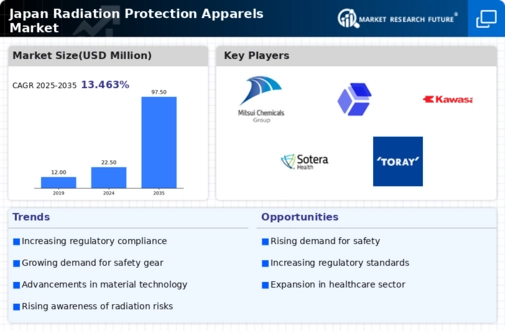Growth of the Healthcare Sector
The expansion of the healthcare sector in Japan is a significant driver for the radiation protection-apparels market. With an increasing number of diagnostic imaging procedures and cancer treatments involving radiation, the need for protective apparel has surged. Hospitals and clinics are investing in high-quality radiation protection clothing to ensure the safety of both patients and healthcare professionals. This trend is expected to contribute to a market growth rate of around 7% over the next few years. As the healthcare sector continues to evolve, the demand for specialized apparel designed to mitigate radiation exposure will likely remain robust.
Increasing Awareness of Radiation Risks
The rising awareness of radiation exposure risks among the Japanese population is a crucial driver for the radiation protection-apparels market. Educational campaigns and media coverage have highlighted the potential health hazards associated with radiation, particularly in medical and industrial settings. This heightened awareness has led to a growing demand for protective apparel designed to shield individuals from harmful radiation. As a result, the market is projected to experience a compound annual growth rate (CAGR) of approximately 6.5% over the next five years. The increasing focus on personal safety and health is likely to propel the adoption of specialized clothing, thereby expanding the radiation protection-apparels market.
Rising Demand from Industrial Applications
The radiation protection-apparels market is also being driven by the rising demand from industrial applications, particularly in sectors such as nuclear energy and manufacturing. As industries that utilize radiation technology expand, the need for protective clothing to safeguard workers becomes increasingly critical. This demand is further fueled by the implementation of safety protocols and training programs aimed at minimizing radiation exposure. The market is anticipated to grow by approximately 4.5% annually, reflecting the ongoing commitment to worker safety and health. Consequently, manufacturers are likely to develop innovative solutions tailored to meet the specific needs of various industrial applications.
Regulatory Framework and Compliance Requirements
The stringent regulatory framework governing radiation safety in Japan plays a pivotal role in shaping the radiation protection-apparels market. Compliance with safety standards set by governmental bodies necessitates the use of protective clothing in various industries, including healthcare, nuclear energy, and research. As organizations strive to meet these regulations, the demand for certified radiation protection apparel is expected to rise. This compliance-driven market is projected to grow at a rate of 5% annually, reflecting the increasing emphasis on safety and risk management. Consequently, manufacturers are likely to focus on producing apparel that meets or exceeds these regulatory requirements.
Technological Innovations in Protective Materials
Technological advancements in the development of protective materials are significantly influencing the radiation protection-apparels market. Innovations such as lightweight, flexible fabrics that offer enhanced radiation shielding capabilities are becoming increasingly available. These materials not only provide better protection but also improve comfort and wearability, which is essential for users in various sectors, including healthcare and nuclear industries. The market is expected to reach a valuation of approximately $500 million by 2027, driven by these innovations. As manufacturers continue to invest in research and development, the introduction of new materials is likely to enhance the overall appeal of radiation protection apparel.
















Leave a Comment